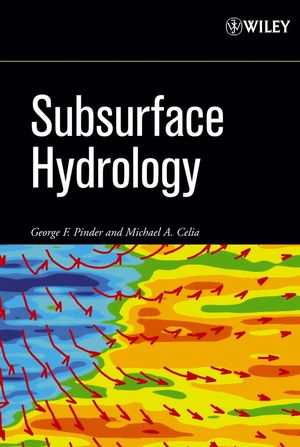Subsurface HydrologyISBN: 978-0-471-74243-2
Hardcover
488 pages
September 2006
 This is a Print-on-Demand title. It will be printed specifically to fill your order. Please allow an additional 15-20 days delivery time. The book is not returnable.
|
||||||
1. Water and the Subsurface Environment.
1.1 Groundwater Hydrology.
1.2 Groundwater and the Hydrologic Cycle.
1.3 Groundwater as a Resource.
1.4 Groundwater and the Subsurface.
1.5 The Near-surface Environment.
1.5.1 Soil.
1.6 Porosity.
1.6.1 Primary Porosity.
1.6.2 Secondary Porosity.
1.7 SoilWater.
1.8 Groundwater Contamination.
1.8.1 Naturally Occurring Groundwater Contaminants.
1.8.2 Anthropogenic Contaminants.
1.8.3 Superfund.
1.9 Quantitative Analysis of Groundwater Problems.
1.9.1 Governing Equations.
1.9.2 Field Data.
1.9.3 Behavior of Groundwater Systems.
1.10 Summary.
1.11 Problems.
2. Fluid Flow and Mass Transport.
2.1 Fluid Pressure.
2.2 Hydraulic Head.
2.3 Fluid Potential.
2.4 Concept of Saturation.
2.5 The Darcy Experiment.
2.5.1 Extended Forms of Darcy?s Law.
2.5.2 Example of a Groundwater Flow Velocity Calculation in Two Dimensions.
2.5.3 Additional Concepts of Fluid Potential.
2.6 Fluid Flow andMass and Energy Fluxes.
2.6.1 Convection, Diffusion, and Dispersion.
2.6.2 The Phenomena of Adsorption and Retardation.
2.7 Summary.
2.8 Problems.
3. The Geologic Setting.
3.1 Unconsolidated Deposits.
3.1.1 Clastic Sedimentary Environment.
3.1.2 Precipitate Sedimentary Environment.
3.1.3 Glacial Environments.
3.2 Consolidated Rocks.
3.3 Metamorphic Rocks.
3.4 Igneous Rocks.
3.5 Geologic Time.
3.5.1 The Hadean Era.
3.5.2 The Archaean Era.
3.5.3 Proterozoic Era.
3.5.4 Paleozoic Era.
3.5.5 Mesozoic Era.
3.5.6 Cenozoic Era.
3.6 Field Investigation.
3.6.1 Near-surface Investigation.
3.6.2 Deep Subsurface Investigation.
3.7 The Geohydrological Record.
3.7.1 The Cross Section.
3.7.2 The ContourMap.
3.8 TheMeasurement of State Variables.
3.8.1 Water-levelMeasurements.
3.8.2 Solute ConcentrationMeasurements.
3.9 Summary.
3.10 Problems.
4. Water Movement in Geological Formations.
4.1 Conservation of FluidMass.
4.2 Conservation of FluidMass in a PorousMedium.
4.3 Groundwater Flow Equations.
4.3.1 The Governing Equation.
4.3.2 Parameter Estimates.
4.3.3 Boundary Conditions.
4.3.4 Initial Conditions.
4.3.5 Sources and Sinks.
4.4 The Free Surface Condition.
4.5 Reduction in Dimensionality.
4.5.1 Physical Dimensions of the Model.
4.5.2 Vertical Integration of the Flow Equation.
4.5.3 The Free-Surface Condition in the ArealModel.
4.6 Salt-water Intrusion.
4.7 One-dimensional Formulation.
4.8 Cylindrical Coordinates.
4.9 Summary.
4.10 Problems.
5. Analytical Solutions for Flow Problems.
5.1 One-dimensional Flow Problems.
5.1.1 Darcy Column Experiments.
5.1.2 One-dimensional Regional Flow.
5.1.3 Flow in Radial Coordinates.
5.2 Two-dimensional Flow Problems.
5.2.1 Graphical Solutions.
5.2.2 Analytical Solutions in Two Dimensions.
5.3 Summary.
5.4 Problems.
6. Well Hydraulics.
6.1 The Slug Test.
6.1.1 HvorslevMethod.
6.1.2 Cooper-Bredehoeft-Papadopulos.
6.2 Pumping Tests.
6.2.1 ThiemMethod.
6.2.2 TheisMethod.
6.2.3 Cooper-JacobMethod.
6.2.4 Papadopulos-CooperMethod.
6.2.5 Hantush Leaky AquitardMethod.
6.2.6 Neuman Method for Unconfined Aquifers.
6.2.7 Theis RecoveryMethod.
6.2.8 ImageWell Theory.
6.3 Summary.
6.4 Problems.
7. Numerical Solutions of the Groundwater Flow Equation.
7.1 Introduction to NumericalMethod.
7.2 Polynomial Approximation Theory.
7.3 Finite-differenceMethods.
7.3.1 Finite Difference Representation of the Groundwater Flow Equation.
7.3.2 Finite Difference Method in Two Space Dimensions.
7.4 Finite ElementMethods.
7.4.1 Galerkin?sMethod.
7.4.2 Two Dimensional Finite Element Formulation.
7.5 Finite Volume Formulation.
7.5.1 Two-Dimensional Finite Volume Formulation.
7.6 Finite ElementMethod and the Transient Flow Equation.
7.7 Simulation under Parameter Uncertainty.
7.7.1 Introduction to Probability.
7.7.2 RandomFields.
7.7.3 The Semivariogram.
7.7.4 Kriging.
7.7.5 Solving Problems Involving Random Hydraulic Conductivity Fields.
7.8 Summary.
7.9 Problems.
8. Contamination of Subsurface Water.
8.1 Types of Contaminants.
8.2 Mass Conservation.
8.3 Mass Conservation in a PorousMedium.
8.3.1 The Dispersion Relationship.
8.3.2 One-dimensional Transport.
8.4 Retardation.
8.5 Chemical Reactions.
8.6 Numerical Solution to the Groundwater Transport Equations.
8.7 Summary.
8.8 Problems.
9. Groundwater-Surface Water Interaction.
9.1 Introduction.
9.2 Fluid Dynamics Near the Stream.
9.2.1 Bank Storage Effects.
9.2.2 Influence of PumpingWells.
9.2.3 Hydrograph Separation.
9.3 Chemical Interaction.
9.4 Summary.
9.5 Problems.
10. Remediation.
10.1 Pump-and-Treat.
10.1.1 Inward-Gradient Approach.
10.1.2 Risk-Based Approach.
10.2 Soil Vapor Extraction (SVE.
10.3 Air Sparing.
10.4 Some Basic Chemistry.
10.4.1 Oxidation-Reduction Reactions.
10.4.2 Organic Chemistry.
10.5 Permeable Reactive Barriers.
10.6 Bioremediation.
10.6.1 The Process.
10.6.2 Bioremediation as a Remediation Concept.
10.7 Optimal Design of Remediation and Management Strategies.
10.7.1 Gradient-constrained Pump and Treat Designs.
10.7.2 Risk-constrained Pump and Treat Designs.
10.8 Summary.
10.9 Problems.
11. Multi-fluid Flow and Transport.
11.1 Problems involvingMultiple Fluids.
11.1.1 Unsaturated Soils.
11.1.2 Non-aqueous-phase Liquids.
11.1.3 Fluid Components and Groundwater Contamination.
11.2 Governing Equations.
11.2.1 Mass Balance Equations.
11.2.2 Darcy’s Law for Multi-fluid Flow.
11.2.3 Capillary Pressure and Governing Equations.
11.2.4 Functional forms for Relative Permeability and Capillary Pressure.
11.2.5 Equation for Solid Phase.
11.2.6 Equations for Components within a Fluid.
11.2.7 Equations for Components within the Solid.
11.2.8 Reactions, Mass-transfer, and Source/sink Terms.
11.3 The Unsaturated Zone and Richards’ Equation.
11.3.1 Properties of Air and Water, and Richards’ Assumption.
11.3.2 Richards’ Equation forWater Flow.
11.3.3 Water and Air Dynamics in the Unsaturated Zone.
11.3.4 Plant Roots and Evapotranspiration.
11.4 Solution Methods Multi-fluid Flow Equations.
11.4.1 Simplified Solutions for Unsaturated Flow.
11.4.2 Numerical Solution of Richards Equation.
11.4.3 Analytical Solutions for Two-fluid Flow: The Buckley-Leverett Solution.
11.4.4 Numerical Solutions for Two-fluid Systems.
11.5 Summary.
11.6 Problems.



